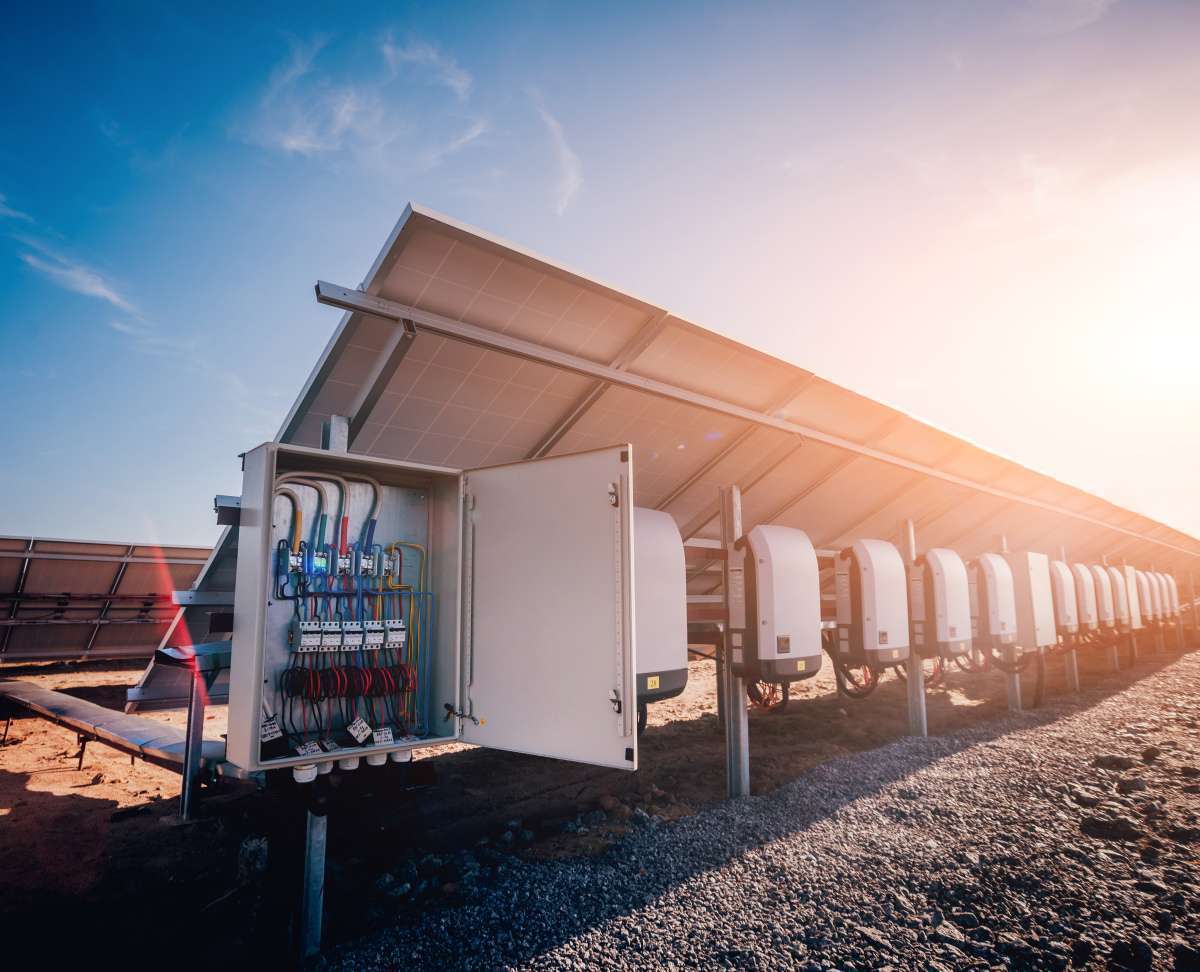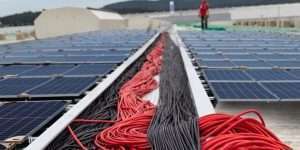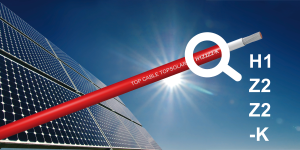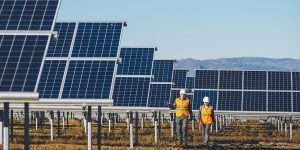High temperatures can affect different components of PV systems. Inverters can fail, the efficiency of…
Considerations when choosing a photovoltaic cable
In a photovoltaic installation, the sun’s energy is converted directly into electrical energy. The cable through which this electrical energy circulates is therefore one of the most critical elements in a solar installation. The optimal selection of the photovoltaic cable will optimise the performance of the solar farm in the short, medium and long term.
THE PHOTOVOLTAIC CABLE IS A CRITICAL ELEMENT IN A SOLAR INSTALLATION
In PV installations, the high volume of cables makes the use of the highest quality PV cable paramount. There have been many cases where standard photovoltaic cable has cracked and corroded over the years, resulting in additional replacement and maintenance costs and electrical losses in PV installations.

EN 50618, THE NEW STANDARD AT 1500V
In recent years, the leading solar panel manufacturers in the PV industry have improved their technology, increasing the operating voltage up to 1500 V DC. This new operating voltage has a direct impact on the cost-effectiveness of the project, resulting in significant cost reductions, longer links and fewer junction boxes and wiring.
Therefore, all DC components also had to be upgraded to a higher operating voltage, and international regulatory bodies have issued new standards and certificates to ensure their suitability.
For this particular photovoltaic cable, the new standard, published in 2014, is EN 50618. This standard specifies that cables in PV system installations must have a rated continuous voltage of up to 1.5 kV. The international safety qualification standard for PV modules – IEC 61730 – requires a photovoltaic cable to conform to EN 50618.
It is important for specifiers to check whether the PV cable supplied by their suppliers conforms to the current standards, as these set higher requirements, e.g. for general low voltage cables.
PLANNING AND DESIGN OF A PHOTOVOLTAIC PLANT: WHICH CABLES ARE INCLUDED?

Photovoltaic plant with string box

Photovoltaic plant with string inverter
A photovoltaic plant consists of panels, cables, junction boxes, electrical and electronic equipment. To understand how the installation works, we will divide it into parts and types of cables.
String cables
These are the cables that run from the PV panel to the concentrator or Stringbox.
String box
This is a junction box that includes devices to control and connect the PV modules.
It is the transition point where the cables – 4 and 6 mm2 cross-section – connect to the DC feeder and switch to larger aluminium cables – 95 to 300 mm2 -.
DC power cables
These are the cables – usually made of aluminium – that connect the stringboxes to the inverters.
Inverter
A converter that transforms the DC power from the PV generator into alternating current (AC).
AC power cables
The cables – usually aluminium – that connect the inverters to the transformer.
Transformer
A device that transforms the low voltage current (1500V) into medium voltage (12 / 20kV).
Why all these processes? Because photovoltaic panels produce Direct Current (DC). The voltage that we have in our homes and that which travels through the electrical networks is Alternating Current (AC), so it has to be transformed.
Medium voltage cables
These are the cables -usually made of aluminium- that connect the transformer to the public electricity network. A distinction must be made between the private area, which corresponds to the perimeter of the installation, and the public area, which belongs to the electricity company.
PHOTOVOLTAIC CABLE IN A SOLAR INSTALLATION
What are the most common photovoltaic cables in a solar installation?
- TOPSOLAR® H1Z2Z2-K
- TOPSOLAR® PV AL
- TOPSOLAR® PV AL 1500V HEAVY DUTY
- TOXFREE® ZH OUTDOOR H07Z1-K (AS) Cu/Sn
- X-VOLT® RHZ1 / HEPR
- TOPFLEX® H07V-K
- POWERFLEX® RV-K / RZ1-K
TOPSOLAR® H1Z2Z2-K
- String cables, type H1Z2Z2-K.
- 1500 V photovoltaic cable (specially designed for photovoltaic installations).
- TOP CABLE TOPSOLAR® H1Z2Z2-K photovoltaic cable design:
- Tinned copper conductor (required by standard to prevent corrosion).
- LSZH insulation.
- LSZH rubber outer sheath.
- TÜV EN50618 certificate. To pass this certificate, the cables require:
- 1500V / 1500V (1,5 / 1,5kV) in direct current.
- A minimum of 20.000 hours at 120ºC.
- + 25 years at 90ºC.
- Submersible AD7 (Our cable is AD8, better submersible performance).
- UV resistant.
- European CPR (Construction Products Regulation) Dca-s2a,d2,a2.
- Most common cable cross-sections: 1×4, 1×6 1×10 mm2.
WHY CAN’T WE USE A STANDARD POWER CABLE IN A PHOTOVOLTAIC INSTALLATION?
Until 2014, this cable conformed to TÜV 2PFG1169, but has since changed to EN 50618, which stipulates that the voltage of the cable must not exceed 1.5kV.
The essential difference between an H1Z2Z2-K photovoltaic cable and a standard cable is that the voltage between the conductor and earth is 1500V instead of the 900V of the standard cable.
| Voltages (kV) continuous | Standard power cable type RV-K 0.6 / 1kV | Solar cable H1Z2Z2-K 1,5 / 1.5kV |
| Voltage between conductor and ground (Uo) | 0,9 kW | 1,5 kW |
| Voltage between conductors (U) | 1,5 kV | 1,5 kV |
| Maximum voltage (Um) | 1,8kV | 1,8 kV |
| Standard | — | EN 50618 |
A photovoltaic installation requires a minimum of 20,000 hours at 120ºC and 25 years at 90ºC.
To guarantee this performance, a premature ageing test (known as the Arrenhius test) of 6,000 hours at different temperatures is carried out to extrapolate its behaviour at 120ºC.
TOPSOLAR® PV AL
TOP CABLE TOPSOLAR® PV AL 1500V cable design:
- Class 2 aluminium conductor.
- XLPE insulation.
- PVC outer sheath.
- AD8.
- UV resistant cable.
- Most common cross sections: from 1×95 to 1×300 mm2.
- There is still no standard for a 1500V aluminium cable, although it is under study.
TOPSOLAR® PV AL 1500 HEAVY DUTY
TOP CABLE TOPSOLAR® PV AL 1500 HEAVY DUTY cable design:
- Class 2 aluminium conductor.
- Extra-slippery flame-retardant polyolefin insulation.
- Halogen-free outer sheath (LSZH).
- UV resistant cable.
TOXFREE® ZH OUTDOOR H07Z1-K
- Class 5 tinned copper conductor.
- Flame-retardant polyolefin insulation.
- UV resistant cable.
MEDIUM VOLTAGE CABLES
Medium Voltage cables connect the transformer to the electrical distribution network.
Our range of X-VOLT® Medium Voltage cables can be insulated with XLPE or HEPR rubber. They are certified by the main electricity companies.
CABLES FOR AUXILIARY SERVICES
- TOPFLEX® H07V-K yellow/green for connecting all panel structures to earth.
- POWERFLEX® RV-K or TOXFREE® RZ1-K (LSZH version) for all CCTV systems and power supply to motor trackers if the installation includes trackers.
OTHER PHOTOVOLTAIC CABLES SUITABLE FOR SOLAR INSTALLATION
In addition to these more common models, at Top Cable we have a wider range of photovoltaic cable, among which the following cables can be found:
TOP CABLE, MANUFACTURER AND SUPPLIER OF PHOTOVOLTAIC CABLE
Top Cable is a comprehensive manufacturer and supplier for all cable connections in a photovoltaic plant of any size. We manufacture the highest quality cables, renowned in the renewable energy industry for their excellent strength and performance.
More than 10 GW of solar power plants worldwide operate reliably with our photovoltaic cables.
If you have a project in hand or you have to start a new project soon, do not hesitate to contact our sales team through this link.




